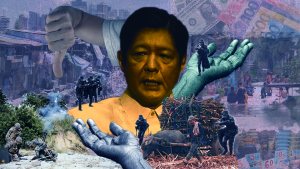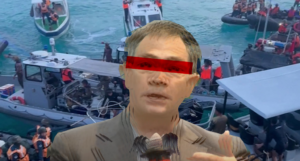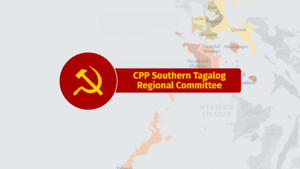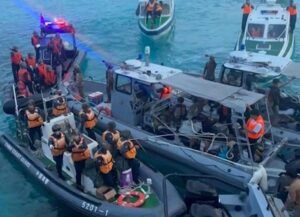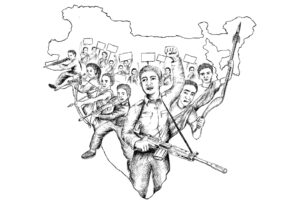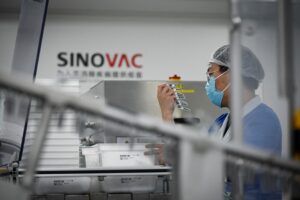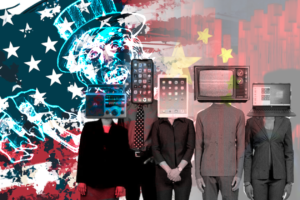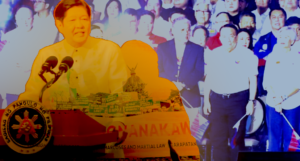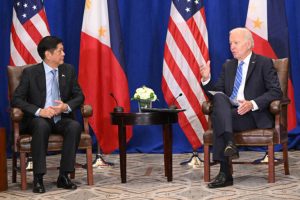Intensify the people's war against the tyranny and terrorism of the US-Duterte fascist regime
The Central Committee of the Communist Party of the Philippines (CPP) salutes all Red fighters and commanders of the New People’s Army (NPA) on the occasion of its 49th anniversary. The Central Committee extends the highest honors to all of the NPA’s heroes and martyrs who made the ultimate sacrifice in serving the people.
The Central Committee holds highest respect and admiration for all the NPA veterans, especially the pioneers who broke the ground of the first guerrilla fronts across the country and remained loyal to the revolutionary cause. Through hard work and sacrifices, they were able to build strong foundations for the protracted people’s war to persevere and prosper in the succeeding decades.
The NPA was built practically from scratch in the second district of Tarlac in 1969 when it had 60 Red fighters with nine automatic rifles and 26 inferior firearms and a mass base of 80,000 people. Today, the NPA is a national army of several thousands of Red fighters armed with high-powered rifles. It enjoys deep and wide support among the people, especially among the peasant masses and minority peoples, as well as among the workers and urban intelligentsia and other oppressed sectors.
The New People’s Army continues to grow steadily as it approaches its 50th founding anniversary. Young Red fighters and commanders from among the peasants, workers and urban intelligentsia make up most of its ranks and infuse it with revolutionary vigor, optimism and courage. The NPA’s commitment and determination to serve the people and carry forward the people’s war to greater heights is as strong as ever.
The revolutionary ardor of the NPA radiates and helps inspire the proletariat and oppressed classes and people around the world to wage struggles for democracy, social justice and national liberation. At the same time, the NPA and the people’s revolutionary forces draw inspiration from the struggles of workers, peasants and the broad masses and look forward to an international resurgence of democratic and socialist revolutions as the global capitalist system flounders from one crisis to another.
The NPA and the Filipino people are currently confronted with the brutal all-out war mounted by the US-Duterte fascist regime under its Oplan Kapayapaan. This war has quickly revealed itself to be a war directed against civilians in a futile attempt to terrorize and cow the people and make them submit to the fascist and tyrannical rule of the puppet bureaucrat capitalist regime. However, this has succeeded only in isolating the regime and inciting the people to unite, resist and fight back.
The socio-economic conditions of the people are ever worsening under the neoliberal economic policies of the US-Duterte regime. The toiling masses are increasingly restless and are being stirred to wage all forms of struggles to advance their national and democratic cause. Conditions remain ever favorable for arousing, organizing and mobilizing the people and advancing the national democratic revolution through protracted people’s war to greater heights.
One decade of continuing global depression and resistance
This year marks a decade of global capitalist depression. Since falling into an economic recession in 2008, the US and other leading capitalist countries have suffered invariably from slow growth and, at times, stagnation.
The world capitalist system is afflicted with an insoluble crisis of overproduction resulting from the basic contradiction between private ownership, accumulation and increasing concentration of capital, on the one hand and social production, on the other. The profit-driven rise in productivity has lead to anarchy of production, increasingly large inventories of unsold consumer and capital goods, collapse of commodity prices, destruction of productive forces, interruptions in the cycle or turnover of productive capital, increased financialization and overall economic decline.
The global capitalist economy has yet to decisively reverse its decline since the financial crisis ten years ago. From the six-year low of 2.4% growth in 2016, world GDP growth grew by an estimated 3% last year. Even bourgeois economists believe this growth will not be sustained in the coming years. Economic growth rates in the most developed capitalist economies remain low with the US estimated to have grown by a mere 2.3%, Europe by 2.4% and Japan, 1.7%. Since 2010, Chinese economic growth has been on a steady decline, with the first up tick last year at 6.9% expected to be offset by slower growth targets for 2018.
Just to maintain stagnant low rates of growth in the world economy, large amounts of debt have been incurred by households, corporations and governments. The global public debt is now at the level of USD 230 trillion and is now more than three times the size of the current global GDP. It is the biggest bubble that is now in the process of bursting, together with the asset bubble of the monopoly bourgeoisie, and is anticipated to be a far bigger catastrophe than the financial meltdown of 2008. In the meantime, the failure of the majority of corporations to pay repay their debt has resulted in plant closures, reduction in production and rise of unemployment. The loss of jobs and the failure of households to repay their debts have drastically reduced the middle class in the most developed countries and generated hunger, homelessness and poverty akin to the third world.
The entire capitalist system is slowed down by the large idle inventory of steel, cars, oil, electronics and other commodities. This has slowed down global economic production resulting in large-scale destruction of productive forces.
To unload itself of the oversupply of steel and unproductive capital, China is pushing for one of the largest infrastructure project, the $8 trillion One Belt, One Road Initiative, that will build roads, rails, sea ports, airports and other transportation facilities to connect 68 countries from China to Europe. Similarly, the US government is set to undertake its own massive infrastructure building including the plan to erect a US-Mexico border wall that will cost an estimated $25 billion.
These state-funded or -initiated measures aimed at spurring demand for steel, cement and other construction materials will succeed only in generating temporary employment but will fail to resolve the roots of the global capitalist crisis. These are bound to leave giant white elephants and mountains of bad loans.
Non-imperialist capitalist countries such as Spain, Italy, Greece, Brazil and others suffer gravely from the continuing global depression and from domestic production slowdown. Under pressure from foreign imperialist enterprises, local industrial capacities have deteriorated leading to crisis-proportion unemployment rates.
The majority of countries suffer from backward economic conditions, chronic massive unemployment, foreign exploitation of cheap labor and plunder of land and mineral resources leading to depletion of resources and environmental disasters. The broad masses of workers and peasants suffer from low wages, flexible labor (unstable employment), conversion of agricultural lands to plantations for export crops, loss of food security and other worsening forms of exploitation and oppression.
Inter-imperialist contradictions are deepening and leading to increasingly open conflict amid a multipolar world. There is rising economic protectionism among the leading capitalist powers. US President Trump is aggressively pushing the “America First” policy of the previous regime–higher tariffs of imported steel and other commodities, and the Obama-era tax and other incentives to push US companies to relocate back to the US. It has withdrawn from the Trans-Pacific Partnership and the Trans-Atlantic Partnership. Instead, it is pushing for bilateral arrangements to squeeze the most advantage from its semicolonies.
The Chinese big bourgeoisie and bureaucrat capitalists continue to defend the so-called state enterprises which are, in fact, state monopoly capitalist operations. Meanwhile, the United Kingdom struggles to define the parameters of leaving the European Union (through Brexit) which aim to assert its sovereign right to determine where to invest and with whom to forge trade relations.
There is a rise of ultra-nationalist, militarist and fascist parties and head of states that are outrightly antiworker, anti-migrant and increasingly jingoist, as exemplified by US President Trump. He is equally matched by fellow militarists Vladimir Putin of Russia and Shinzo Abe of Japan. China President Xi Jinping has recently declared himself as president-for-life as he sets his sights on leading China in a battle to define and dominate the global economy.
Under Trump, the US imperialists continue to assert global hegemony and military superiority. It remains number one in terms of the number of air craft carriers, nuclear warheads, number of overseas military bases and military personnel. It continues to peddle weapons to areas of armed conflict, to boost military revenue and spending. It continues to use its military advantage to threaten its imperialist rivals, project dominance over Europe, deploy its forces along Russia’s western borders, assert control of oil resources in the Middle East, and project power in Asia, particularly along China’s southern and eastern seas. The US employs carrot-and-stick tactics against North Korea and Iran, first with threats of a nuclear confrontation then offering to hold summits and negotiations.
Russia and China are exerting efforts to catch up with US military strength. The nuclear arms race seem to have been reignited by the US and Russia, with the US declaring it will develop nuclear weapons in a big way, while Russia made public new capabilities such as hypersonic missiles that travel at ten times the speed of sound and nuclear-powered cruise missiles that can fly indefinitely. Proxy wars such as in Syria as well as armed conflicts in the Middle East and Eastern Europe, continue to erupt between the US and Russia.
China has established its first military base in Djibouti and deployed its first aircraft carrier to transport its troops to Africa. China has been strengthening its Africa foothold to establish its control over vast sources of oil and other minerals such as those used for the production of solar panels, batteries and so on.
A number of countries continue to assert national sovereignty against US hegemony and intervention. The anti-imperialist Bolivarian governments of Cuba, Venezuela, Bolivia and Ecuador continue to withstand US intervention and subversion. Iran and North Korea remain steadfast in upholding their sovereign right to self-defense to develop nuclear technology as a weapon to defend themselves against US aggression.
Democratic people’s struggles daily break out around the world. Mass protests have repeatedly been mounted by workers and peoples of Europe against neoliberal austerity measures imposed by the European Union and IMF/WB such as cuts in social spending including those alloted for pension funds. In the US, mass struggles have been launched by blacks, migrants, women and other oppressed groups against the policies of the Trump government. Workers strikes continue to be mounted in China protesting low wages and oppressive working conditions.
Revolutionary armed struggles continue to be waged in Kurdistan and in other countries for the people’s right to self-determination. People’s wars are being waged in India and the Philippines along the general line of new democratic revolution with a socialist perspective. They serve as torch bearers of Marxism-Leninism-Maoism and the people´s democratic revolution in the transition from the current general crisis of capitalism to the general resurgence of the world proletarian revolution.
The continuing global capitalist crisis, the socio-economic and political conditions favor the growth and resurgence of proletarian revolutionary forces. Across the world, Marxist-Leninist study groups and party-organizing committees are emerging in both capitalist centers as well as in semicolonies and other economically backward countries. This will have the effect of consolidating the proletarian revolutionary forces and enabling them to lead the revolutionary struggles in their countries.
The international proletariat continues to strive to achieve breakthroughs in efforts to develop a new revolutionary upsurge in the people’s democratic and socialist revolutions. There is profound need to study and apply Marxism-Leninism-Maoism to the prevailing concrete conditions in different countries.
Last October 2017, communist and worker’s parties all over the world celebrated the centennial of the Great October Proletarian Revolution in Russia which established the first socialist state and economy. The international proletariat draws lessons from waging socialist revolution and building socialism from 1917 to 1977, as well as from the deleterious rise of modern revisionism preceding the rise of the bourgeoisie from within the Party and state, leading to capitalist restoration and the reversal of the victories of socialist revolution and construction. The grave sufferings of the workers and peasants in Russia, China and other former socialist countries after capitalist restoration point to the necessity and urgency of reinvigorating the international socialist revolution.
Taking the long historical view, the proletariat is ever determined to persevere in the arduous tasks of arousing, organizing and mobilizing the working class and toiling masses in order to build the Party, develop the mass and armed strength of the workers and the people, as well as various united front organizations, in order to fight for their democratic causes and aim to smash and overthrow the bourgeois state in their countries.
The Filipino proletariat is in solidarity with their international class brothers and sisters in striving to break open a new historical era of resurgence of socialist revolution at a higher level.
The national democratic revolution through protracted people’s war in the Philippines under the leadership of the Party has advanced through five decades of perseverance and determination to wage revolutionary struggle amid great adversity. Advancing the revolutionary struggles in the Philippines is the biggest contribution of the CPP and the Filipino working class to the effort of the world’s proletariat to advance the international socialist revolution.
Tyranny and terrorism of the US-Duterte fascist regime amid crisis conditions
The ruling US-Duterte regime has resorted to tyranny and terrorism, deception and demagoguery, as it seeks to perpetuate itself in Malacañang, monopolize political power and suppress the people’s revolutionary resistance amid the deepening economic and political crisis of the ruling system.
The crisis of the ruling semicolonial and semifeudal system continues to worsen under the US-Duterte regime. The economy remains backward, non-industrial and agrarian characterized by low value-added semi-processing of imported components, foreign-controlled large-scale production of crops for export side-by-side with small-scale and individualized agricultural production of rice and other food crops under feudal and semifeudal conditions of exploitation. Local production is import- and debt-dependent resulting in chronic trade deficits and foreign indebtedness. Productivity is on a long-term decline.
The broad masses of workers and peasants suffer from landlessness and landgrabbing, unemployment, worsening forms of flexible labor, slave-like wages, rising cost of living, homelessness, rampant poverty, cuts in social spending and overall deterioration of socio-economic conditions. In the National Capital Region, the P512/day minimum wage is not even half the required family living wage of P1,171. This gap will become even larger with the imposition of new taxes and rapid increase in the prices of basic commodities and services.
The Filipino people hold the Duterte regime responsible for the massacre of 663,000 jobs last year, the biggest annual drop in the number of employed Filipinos in the past 20 years. Despite statistical manipulation, official government data put the unemployment rate at 9.1%. Real unemployment figures, however, reach as much as 20-25%. Because of this, the exodus of Filipino workers seeking overseas jobs continue with close to 4,700 workers leaving the country daily.
The Duterte regime has merely perpetuated the policies of liberalization of trade and investment, deregulation and privatization of public enterprises. Local production remains import-dependent and export-oriented. It remains tied to the global capitalist production chain.
As in the past, Duterte’s economic policy aims mainly to attract foreign investments by providing the infrastructure and making available semi-skilled and low-wage workers. The Duterte government is set to release the further shortened Foreign Investment Negative List to allow foreign investors more areas of investment. It is also pushing to amend the Public Service Act to circumvent the constitutional restriction against foreign investments in public utilities. It has put into place the TRAIN package of new taxes that is set to generate at least P600 billion to assure foreign creditors of the country’s ability to pay its debts.
Amid continuing global depression, and stiff competition among other semi-processing countries, the Philippines failed to draw in a significant amount of foreign direct investments. Last year, foreign investments in labor enclaves generated only 78,000 jobs. Duterte’s promise to generate “2 or 3 million jobs” yearly through his “Build, Build, Build” will not likely materialize as the expected funds from China for these infrastructure projects are not forthcoming. Duterte’s expectation of USD 167 billion loans from China is extremely exaggerated and is mere fantasy. Whatever amount he gets will be at high interest and other onerous conditionalities.
Duterte’s “industrialization” declarations are mere sound bytes. In fact, among the proposed amendments to the 1987 constitution being pushed by Duterte’s minions is the removal of “industrialization” as a cornerstone economic policy of the country.
The Duterte regime has all but completely abandoned land reform. After around 30 years, large tracts of feudal lands remain under the monopoly ownership of big landlords. The CARP/ER is designed to fail as a land reform program. It ignores the peasants clamor for social justice and instead requires them to pay regular amortization. It allowed various schemes which perpetuates landlord control of the land.
Despite his declared antipathy against the Aquino-Cojuangco oligarchs, Duterte has failed to put the 6,453 hectares of Hacienda Luisita under land reform. He is also pushing for the conversion of agricultural lands to plantations, especially in Mindanao, which would surely displace thousands of peasants and minority peoples from their land.
Duterte cannot be expected to conduct any serious campaign against corruption. He has acted to rehabiltate the Marcoses politically and to nullify the plunder charges against the Arroyos, Estradas and Enrile in exchange for their support during the 2016 presidential elections. He has also turned Napoles from a key accused to a state witness for the purpose of blackmailing Aquino, Abad and other key officials of the Aquino regime and letting them go scotfree upon their cooperation with himself.
Bureaucrat capitalist corruption under the Duterte regime continues to worsen. Duterte has alloted himself P2.5 billion in so-called “intelligence” and “confidential” funds, which is five times bigger than those of the previous regime. He uses his so-called discretionary funds to bribe military and police officers, from the generals to the colonels, to ensure their loyalty. These funds are also widely believed to be used to run the operations of his network of death squads. He also uses his control of the budget to consolidate his supermajority control of the House of Representatives. He also uses his funds to dig up or make up dirt against his foes and allies to arm-twist them and make them submit to his whim.
Duterte has set aside the generally accepted methods of public bidding in favor of the so-called “Swiss Challenge” system of unsolicited project proposals from private investors. Big bourgeois compradors and bureaucrat capitalists are set to benefit in the form of billions of pesos of funding and kickbacks from government contracts.
Duterte is an inveterate demagogue and swindler. He takes advantage of the widespread dissatisfaction of the people with the ruling system and pretends to side with them. He draws public attention by making noisy declarations merely to cover up his real schemes. His “war on drugs” conceals his association with the big drug syndicates. His “war on corruption” conceals his bureaucrat capitalist operations. His “I hate the Americans” conceals his subservience and mendicancy. His “I will destroy the oligarchs” conceal his schemes to take away their businesses in favor of his election supporters. His “I will bring peace to this land” conceal his bloodthirst and obsession with war.
So far, the only declaration to which he has been true to is “I love Marcos.” He also loves Gloria Arroyo. He has established alliances with the most detested icons of fascism and corruption to pool together their billions of bureaucratic loot and political loyalties to secure their dynasties and perpetuate their close relatives in power.
With majority of justices appointed by Arroyo and himself, Duterte has established control of the Supreme Court. He, however, is unsatisfied and demands the removal of the chief justice who has been critical of his policies and schemes to monopolize political power. Duterte demands as well the removal of Aquino-appointed ombudsman.
Through tyrannical methods, Duterte is pushing for the centralization and monopolization of political power. His advocacy for distributing power through federalism is a smokescreen. The real objective is to seat himself at the center and top of the reactionary state as a fascist dictator, either through a declaration of martial law which completely disregards the 1987 constitution, or through charter change to a pseudo-federal constitution by having him seat as president in a protracted period of transition without elections. The bureaucrat capitalist Duterte seeks to perpetuate himself and his family in power.
Duterte has unleashed the worst forms of state terrorism and fascist violence against the Filipino people. He brazenly incites his police and military forces to trample on human rights, in total disregard of local and international public opinion. He has raised fascist impunity to the level of state policy with his declaration of Philippine withdrawal from the International Criminal Court.
Within his first year in power, Duterte has mounted three wars resulting in widespread death and destruction. The murderous frenzy of police and armed vigilantes which Duterte incited in his “war on drugs” has resulted in the killing of more than 13,000 people, mostly those accused of being street peddlers and users of illegal drugs. Police reports record 7,000 more ¨homicide” cases in the Oplan Tokhang tally sheet which are supposed to be under investigation as possibly the result of a war among the drug syndicates, which is a well-known pretext for extrajudicial killings by the police.
Not a few innocent people, youth and children have been killed. His “war on drugs” has been totally discredited after it was revealed that his son, Paolo, and his Davao associates, are themselves drug smugglers with the discovery last year of a P6.4 billion shipment of shabu from China. It is now apparent that Duterte’s “war on drugs” is merely a subterfuge to conceal his real aim of eliminating rival drug syndicates (with the murder of Espinosa and the Parojinogs in Iligan) and making them submit and pay for their protection (such as what happened with the dropping of charges against Kerwin Espinosa, Peter Co and Peter Lim).
The Marawi Siege (May-October 2017) is part of the continuing war against the Moro people. For five months, the AFP, supported by US weaponry and military advisers, pounded Marawi City with daily aerial bombardment in the name of “smashing the ISIS-inspired Maute group”. It systematically leveled the entire city. More than 400,000 people in and around Marawi were forced to leave their homes. At least 800 people, mostly civilians, were killed. More than 2,000 people remain missing. Residents are prevented from returning to their homes. A large portion of Marawi is now being claimed by the AFP and the US military as a military reservation, while people are being cramped into small areas of “temporary housing.”
The Marawi Siege has roused widespread anger among the Bangsamoro people, particularly among the Maranaw people. It has put to question the sincerity of Duterte to peacefully resolve the Moro conflict. His repeated promise to enact the Bangsamoro Basic Law remains unfulfilled. Moro armed resistance is bound to break out across the Bangsamoro as the US-Duterte regime continues to trample upon their right to self-determination.
The AFP launched the Oplan Kapayapaan war of suppression at the start of 2017 and imposed martial law in Mindanao in May. Duterte publicly declared the termination of peace negotiations with the NDFP around November after months of refusing to proceed with negotiations on the substantive agenda of socio-economic reforms, and prematurely demanding the revolutionary forces to bind themselves to an indefinite ceasefire agreement. He subsequently declared the CPP and NPA as terrorist organizations, to seek further US involvement in local counter-insurgency operations.
Duterte brandishes the terror-tagging of the CPP as a weapon to intimidate, cow and silence those who oppose his scheme to setup a dictatorship. He launched an anti-communist witch-hunt against 600 individuals, including NDFP peace consultants, human rights advocates, prominent personalities and activists, leaders and elders of minority peoples and so on. The AFP undertake operations to surveil and assassinate leading cadres of the Party.
Duterte’s Oplan Kapayapaan is essentially a continuation of the 2011-2016 Oplan Bayanihan. It is set to be his most brutal and cruel war. To achieve its objective of cutting the strength of the NPA “by half”, the AFP plans to recruit a total of 15,000 new troops in 2017-18 and complete the formation of ten new battalions. Duterte has declared his plan to acquire helicopter gunships, jet fighters, surveillance drones and other weaponry to beef up the AFP.
Duterte has ordered the AFP to employ all their assets to “flatten the hills,” “shoot the vagina” of NPA women Red fighters, “bring the heads of the NPA in iced buckets” and other directives that incite them to commit grave violations of human rights and international humanitarian law. Under Duterte, the AFP and its agents have summarily killed close to a hundred peasant leaders, more than 20 unionists and scores of activists.
The AFP has mounted campaigns of aerial bombardment and artillery attacks against civilian communities. It has specifically targeted Lumad areas which Duterte wants to offer to foreign companies as plantation or mining areas. Under Oplan Kapayapaan, the AFP has subjected hundreds of barangays to armed occupation of soldiers in violation of international humanitarian law. It has forced thousands of people to pose as “NPA surrenderees,” blurring the line between civilians and armed combatants, and putting the people’s lives at risk. As a result of all these, tens of thousands of people are forced to leave their communities to seek safety. Duterte’s hands are dripping in blood for the growing list of brutal crimes against the people.
Growing resistance and accelerated growth of NPA
The demagoguery and deception, tyranny and terrorism of the fascist US-Duterte regime has enraged the Filipino people and stirred them to unite and fight back through different forms of resistance.
There is a growing civil liberties movement, the most prominent of which is the Movement Against Tyranny, in the face of Duterte’s outright contempt of human rights and all-out attacks against people’s freedoms, in Mindanao and across the country. There is a strong clamor for justice for all the drug killings perpetrated by the police and Duterte’s death squads.
The Filipino people demand justice for all victims of Duterte’s war of destruction against Marawi. They demand an end to the AFP’s media deception and for the complete picture to be revealed. The people of Marawi demand to return to their homes and for all their dead and missing to be accounted for and indemnified.
The Filipino people demand an end to Duterte’s use of aerial bombing as a weapon of terror and destruction against the people. They demand Duterte to stop aiming his cannons at the Lumad community schools and peasant communities. They demand an end to the armed occupation of rural villages, the food and aid blockades, the curfews and restrictions on people’s movements. They demand an end to the extrajudicial killings of activists. They demand the military to stop parading their own paramilitary forces, their relatives and other civilians as NPA “surrenderees.”
They cry for justice for the victims of the Lake Sebu massacre, the Batangas City bombings, the North Cotabato and Bukidnon bombings, the Maco torture and frustrated killings of activists, the killing of Obillo Bay-ao and numerous other crimes perpetrated by Duterte’s fascist troops under his orders.
There is a growing united front against the Duterte regime. A broad range of forces are coming together against his various schemes to set up a dictatorship. They oppose his charter change scheme to establish a presidential-federal form of government and retain him in Malacañang during a 10-year transition. They oppose his arm-twisting of the Supreme Court to remove the chief justice.
National democratic organizations are at the core of the broad anti-Duterte movement. They establish cooperation with various forces on a broad range of issues such as denouncing widespread extrajudicial killings, defense of press freedom, opposition to “cha-cha” and defense of Sereno against Duterte’s moves to remove her as chief justice to have absolute control of the Supreme Court. They are mounting mass protest actions that are steadily gaining ground.
As the Duterte regime become more tyrannical and restrict democratic rights and freedoms, more and more people are fighting back and waging various forms of resistance. Millions are being roused and are coming to realize the justness and historical necessity of waging revolutionary armed struggle to put an end to the Duterte regime and advance the overall revolutionary cause.
Indeed, the total number of new NPA recruits during the first year and a half of the Duterte regime is already 55% more than the accumulated number of recruits in the previous four years under the Aquino regime (2012-2016). There is a steady increase in the number of young intellectuals from the cities joining the NPA. Duterte is proving to be the No. 1 recruiter for the NPA. He starkly represents all that is oppressive, exploitative and evil. His cruelty is rousing increasing numbers of people to fight back.
In the past year, the NPA launched close to a thousand tactical offensives and various types of military actions across the country, including more than 700 across Mindanao. This demonstrates the NPA’s determination to resist the fascist terror unleashed by the US-Duterte fascist regime. Units of the NPA in Luzon and Visayas, in particular, have launched tactical offensives in the provinces of Kalinga, Abra, Ilocos Sur, Cagayan, Quirino, Nueva Vizcaya, Laguna, Batangas, Quezon, Mindoro, Sorsogon, Camarines Norte, Camarines Sur, Eastern Samar, Wetern Samar, Leyte, Negros Occidental, Capiz, and so on. Meanwhile, NPA units in Mindanao have largely sustained the level of intensity of their offensives of previous years, just as the AFP began widespread deployment of their units in the guerrilla zones. Tactical offensives across the country force the enemy forces to overstretch themselves.
Many of the tactical offensives mounted by the NPA in the past year were successful in terms of annihilitating and disarming enemy troops. The NPA seized no less than 350 firearms in these offensives. These victories validate the correctness of applying guerrilla tactics of concentration, dispersal and shifting, taking advantage of the NPA’s superior knowledge of the physical terrain and deep support among the masses. However, a number of NPA tactical offensives met failure. Lessons must be drawn from both positive and negative experiences with the aim of raising the capability of the NPA to launch more tactical offensives and defeat AFP defenses and counter-offensive measures.
Intensify the people’s war against tyranny and terrorism
The Central Committee of the Communist Party of the Philippines directs the New People’s Army to further strengthen itself and intensity the revolutionary armed resistance to defend the people against the worsening terrorism and tyranny of the US-Duterte regime. The NPA must do its utmost to make Duterte and his minions accountable for the growing list of bloody crimes against the Filipino people.
The legal national democratic forces are actively uniting broad democratic forces to defend civil liberties, oppose Duterte’s “cha-cha” and other schemes. More crucial, however, they must expose the Duterte regime’s fascist attacks against the toiling masses of peasants and workers, especially in the course of conducting the Oplan Kapayapaan war of suppression, and mobilize increasingly large number of people in protest actions and other forms of resistance.
They must link up these issues with the democratic sectoral and multisectoral struggles (for wage increases, free tuition, against new taxes and so on); with the anti-feudal struggles of peasants in the countryside and the struggle for the right to self-determination of the minority peoples; as well as with the broad anti-imperialist cause, exposing and opposing, in particular, US military aid (drones, helicopters, bullets and bombs) to the Duterte regime and granting extra-territorial rights to US military forces through the EDCA, VFA and other one-sided agreements.
The NPA wages armed struggle as the lynchpin in the people’s resistance against the Duterte regime’s fascist tyranny. As in the struggle against the US-Marcos dictatorship, the armed struggle serves as the people’s principal weapon to fight the US-Duterte regime’s brutal armed suppression. Its all-out fascist attacks further underscores the pivotal importance of waging armed struggle to attain the revolutionary aspirations of the people.
The NPA must resolutely advance the people’s war and frustrate the declared plan of the US-Duterte regime to defeat it by 2018. The NPA must launch extensive and intensive guerrilla warfare throughout the entire archipelago to force the AFP to overstretch and prevent these from concentrating their forces in one focus area for a prolonged period.
The NPA must strive to gain and develop its initiative and flexibility at all times. The regional or subregional operations commands of the NPA must be be able to direct their forces to quickly concentrate, disperse and shift in order to move out of the enemy’s focus operations, strike from the enemy’s rear or flank and hit at the enemy´s several weak and isolated points. The various commands of the NPA in interlocking guerrilla fronts or interlocking regional, subregional or provincial border areas, must be able to establish different types of coordination in order to more effectively confront enemy campaigns at the interregional and regional levels.
The NPA commands across the entire Mindanao must be able to take full advantage of the size and spread of their guerrilla fronts in order to boldly intensify, heighten and strengthen guerrilla warfare as the broad masses of peasants and workers mount all forms of resistance. Coordination and cooperation at the Mindanao level is quickly developing. Interregional, regional and subregional plans must aim to frustrate the deployment of several AFP battalions in so-called “peace and development” operations to occupy villages across wide areas in the countryside.
Commands of the NPA in Luzon and Visayas must exert full effort to mount tactical offensives or campaigns based on their current strength and capability and aim to rapidly increase the number of NPA Red fighters, boldly expand the number of guerrilla fronts and develop and intensify guerrilla warfare.
In calling for an intensification of tactical offensives, the Party reiterates the NPA’s strategic task of carrying out protracted people’s war by waging extensive and intensive guerrilla warfare on the basis of an ever-widening and -deepening mass base. In launching tactical offensives against the enemy, the NPA applies guerrilla tactics of concentration, dispersal and shifting, takes advantage of favorable terrain and relies on the support of the people. The NPA targets the weak points of the enemy and mounts offensives with a plan for 100% certain victory.
The NPA must aim to systematically develop its force structure, build company-sized guerrilla fronts with the correct balance of vertical and horizontal forces. Units of the NPA must pay attention to the dialectics between expansion and consolidation and raise their capability to advance wave upon wave and intensify and advance guerrilla warfare in a sustained manner.
To deepen, develop and strengthen the support of the broad masses of peasants, the NPA must carry out, as a general policy, the minimum land reform program on a widescale. There must be widespread and sustained municipal, district, provincial or regional level campaigns for reducing land rent, interest rates and fees for irrigation, work animals and farm equipment; raising wages of farm workers; improving farmgate prices for the benefit of peasants; and raising agricultural production and sideline occupations through individual initiative and rudimentary forms of cooperation.
The maximum program of confiscating land from despotic landlords and landgrabbers and distributing this free to peasant tillers should be implemented selectively in areas where the NPA and revolutionary forces are strong enough to carry this out equitably and productively; and where they are capable of frustrating the violent reaction of the enemy. At all times, the NPA must consciously take advantage of the differences among the small, middle and big landlords and the despotic and enlightened gentry.
Victories in land reform struggles profoundly temper the will and determination of the peasant masses to wage people’s war. They provide boundless support to the people’s army and persevere in revolutionary struggle even in the face of enemy’s fascist onslaught. The NPA and the local organs of political power must exert all efforts to sustain these victories and ensure continuous implementation of revolutionary land policies. Efforts of the landlords and reactionaries to reverse these victories and bring back the old policies must be opposed and frustrated. Gains in agrarian revolution must lead to further widening and strengthening of the organs of political power and mass participation in armed struggle, as well as in economic, political, cultural and organizational campaigns.
The NPA must constantly pay attention to the well-being of the peasant masses and work with local mass organizations and organs of political power to address big and small problems such as raising production and improving livelihood, schools for young children, community health, sanitation, water sources, electricity and so on. It must regularly conduct and update social investigation, and hold people’s conferences to sum-up their campaigns and struggles and forge plans to further advance the interests of the people. Local conferences must also be held to unite the people on how to confront and defend themselves against the onslaught of enemy troops.
The NPA must form and train the people´s militia as the local police force in every barangay under revolutionary governance as well as self-defense units within the revolutionary forces. The people’s militia and self-defense units are auxiliary and reserve forces of the NPA. They can serve as a network for intelligence and reconnaissance. They can be armed in great numbers with homemade rifles and handguns.
The NPA should continue to deploy special partisans and commando units to carry out sapper operations to destroy enemy communication systems, military hardware, intelligence systems, supply depots and other specific targets; as well as punitive actions against such specific targets as notorious human rights violators, corrupt officials, drug lords and other criminal syndicates.
The NPA must adapt to the new US-provided sophisticated weapons and overcome these, defensively and offensively. Such weapons, however, remain few and are used dispersedly. The NPA must continue to develop new weaponry and tactics to further enhance its capabilities in waging guerrilla warfare.
The Party must firmly lead the New People’s Army. At all levels, Party cadres in the NPA must constantly aim to raise the unity, capability and determination of all Red fighters and commanders by conducting collective discussions and criticism and self-criticism meetings. The Party must aim to deploy more and more cadres from the workers movement and from the urban intelligentsia to the NPA to serve as Red fighters and commanders and political guides.
Lessons from both positive and negative experiences must be quickly summed-up and shared among the various NPA regional commands. Information and analysis about enemy operations at the national and regional levels should all be promptly reported to the National Operations Command, which in turn, should inform NPA commanders in the different regions and make summary analyses. The NOC carries out the plans of the Central Committee for the nationwide advance the revolutionary armed struggle.
Since its 2nd Congress and the first plenum of the 2nd Central Committee, the Party continues to grow in strength. The Party seeks to further consolidate its gains. Our central leadership has assessed the situation and firmed-up plans for further strengthening the Party, the NPA and all revolutionary forces and for fighting and defeating the US-Duterte regime’s Oplan Kapayapaan.
In addition, it has resolved to undertake a 25-year summing-up and produce a 50-year historical account of the CPP. All regional committees as well as central organs are set to undertake summing-up conferences. The Party aims to draw lessons from almost five decades of waging people’s war in order to further enrich the Party’s theoretical guides with the treasure trove of past and recent experiences in advancing the people’s war in an archipelagic country.
Let us celebrate five decades of revolutionary victories and draw lessons. By summing-up our history, we hope to raise the capability of our young cadres, young Red commanders and fighters to lead in undertaking bigger tasks, as well as learn and draw lessons from their own experiences. Our aim of advancing the people’s war by fulfilling the requirements of waging extensive and intensive guerrilla warfare on an ever-deepening and widening mass base requires the Party to train thousands of young Party cadres, as well as new NPA officers, in leading to undertake the Party’s tasks at various levels and fields of work.
The Party will certainly frustrate the US-Duterte regime’s aim of defeating the NPA or cutting NPA strength by half by the end of this year. The Filipino people and their revolutionary forces will vigorously resist the US-Duterte regime’s Oplan Kapayapaan and oppose all its schemes to establish a fascist dictatorship and perpetuate itself in power.
In the course of resisting the tyranny and terrorism of the US-Duterte regime, the New People’s Army is bound to rapidly expand and gain strength as it intensifies and bring the people’s war to a higher level and bring the national democratic revolution closer to complete victory.

